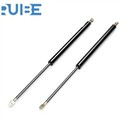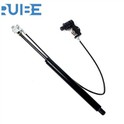When it comes to Bonnet Gas Struts, choosing the right paint is not just about aesthetics; it's a crucial decision that impacts durability, performance, and overall functionality. As a seasoned Bonnet Gas Struts supplier, I've witnessed firsthand the significance of selecting the appropriate paint for these essential automotive components. In this blog, I'll delve into the factors to consider and recommend the types of paint that are best suited for Bonnet Gas Struts.
Factors to Consider When Choosing Paint for Bonnet Gas Struts
1. Corrosion Resistance
Bonnet Gas Struts are often exposed to harsh environmental conditions, including moisture, salt, and various chemicals. Corrosion can significantly weaken the struts over time, leading to reduced performance and potential failure. Therefore, the paint used on Bonnet Gas Struts must provide excellent corrosion resistance. Epoxy-based paints are a popular choice due to their ability to form a protective barrier against moisture and chemicals. They are also highly durable and can withstand the rigors of daily use.
2. Adhesion
Proper adhesion is essential to ensure that the paint stays intact on the Bonnet Gas Struts. The paint must adhere well to the metal surface to prevent peeling, chipping, or flaking. Before applying the paint, the surface of the struts should be thoroughly cleaned and prepared to remove any dirt, grease, or rust. Primer can also be used to improve adhesion and provide an additional layer of protection.
3. Flexibility
Bonnet Gas Struts are subject to constant movement and stress during normal operation. The paint used on these struts must be flexible enough to withstand this movement without cracking or breaking. Acrylic-based paints are known for their flexibility and can adapt to the changing shape of the struts without losing their integrity.
4. UV Resistance
Exposure to sunlight can cause the paint on Bonnet Gas Struts to fade, crack, or peel over time. UV-resistant paints are designed to protect the struts from the damaging effects of ultraviolet radiation. These paints contain special additives that absorb or reflect UV rays, preventing them from penetrating the paint and causing damage.
5. Temperature Resistance
Bonnet Gas Struts can be exposed to extreme temperatures, both hot and cold. The paint used on these struts must be able to withstand these temperature variations without losing its properties. High-temperature paints are available for applications where the struts are exposed to elevated temperatures, such as in engine compartments.
Types of Paint Suitable for Bonnet Gas Struts
1. Epoxy Paint
Epoxy paint is a popular choice for Bonnet Gas Struts due to its excellent corrosion resistance, adhesion, and durability. It forms a hard, protective coating that can withstand harsh environmental conditions and prevent rust and corrosion. Epoxy paint is also available in a variety of colors, allowing for customization to match the vehicle's aesthetics.
2. Acrylic Paint
Acrylic paint is known for its flexibility, UV resistance, and fast drying time. It is a good choice for Bonnet Gas Struts that are exposed to sunlight and require a paint that can withstand constant movement. Acrylic paint is also available in a wide range of colors and finishes, making it suitable for both functional and decorative applications.
3. Powder Coatings
Powder coatings are a type of paint that is applied as a dry powder and then cured under heat to form a hard, durable finish. Powder coatings offer excellent corrosion resistance, adhesion, and UV resistance. They are also available in a variety of colors and textures, providing a high-quality and long-lasting finish for Bonnet Gas Struts.
4. High-Temperature Paint
High-temperature paint is designed to withstand elevated temperatures without losing its properties. It is suitable for Bonnet Gas Struts that are exposed to high heat, such as in engine compartments. High-temperature paint can prevent the paint from cracking, peeling, or fading due to heat exposure.
Application Process
Proper application of the paint is crucial to ensure the best results. Here are the general steps for painting Bonnet Gas Struts:
1. Surface Preparation
Thoroughly clean the surface of the Bonnet Gas Struts to remove any dirt, grease, or rust. Use a degreaser and a wire brush to clean the surface, and then rinse it with water and dry it completely.
2. Sanding
Sand the surface of the struts to create a rough texture that will help the paint adhere better. Use a fine-grit sandpaper and sand in a circular motion.
3. Primer Application
Apply a primer to the surface of the struts to improve adhesion and provide an additional layer of protection. Follow the manufacturer's instructions for applying the primer and allow it to dry completely.
4. Paint Application
Apply the paint to the surface of the struts using a spray gun or a brush. Apply multiple thin coats of paint, allowing each coat to dry completely before applying the next one. Follow the manufacturer's instructions for the recommended number of coats and drying time.
5. Curing
Allow the paint to cure completely according to the manufacturer's instructions. This may take several hours or days, depending on the type of paint used.
Conclusion
Choosing the right paint for Bonnet Gas Struts is essential to ensure their durability, performance, and overall functionality. By considering factors such as corrosion resistance, adhesion, flexibility, UV resistance, and temperature resistance, you can select the paint that is best suited for your specific application. Epoxy paint, acrylic paint, powder coatings, and high-temperature paint are all suitable options for Bonnet Gas Struts. Proper surface preparation and application are also crucial to ensure the best results.
As a Bonnet Gas Struts supplier, we are committed to providing high-quality products and expert advice to our customers. If you have any questions about choosing the right paint for your Bonnet Gas Struts or need assistance with the painting process, please don't hesitate to contact us. We would be happy to help you make the right decision and ensure the long-term performance of your Bonnet Gas Struts.


For more information about our Bonnet Gas Struts and other gas spring products, please visit our website: Bonnet Gas Spring. We also offer a wide range of gas springs for other applications, such as Gas Spring for Kitchen Cabinet and Gas Lift for Furniture.
If you are interested in purchasing our products or have any inquiries, please feel free to contact us for procurement discussions. We look forward to serving you and meeting your gas spring needs.
References
- "Automotive Paint Technology" by John W. F. Magee
- "Corrosion Prevention and Control in the Automotive Industry" by NACE International
- Manufacturer's product literature for epoxy paint, acrylic paint, powder coatings, and high-temperature paint.






